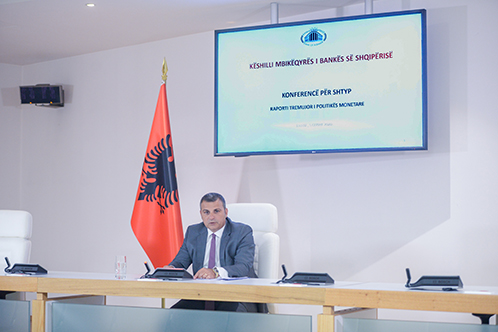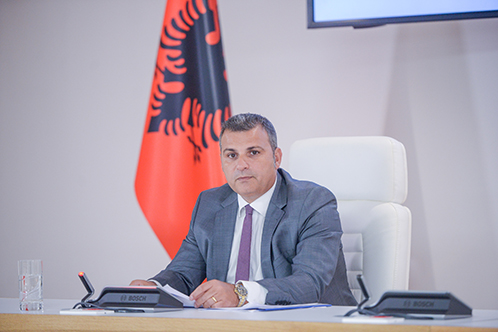BANK OF ALBANIA
PRESS RELEASE
Governor Sejko: Statement to the Press Conference on Monetary Policy Decision, 5 August 2020
Publication date: 05.08.2020
Dear Ladies and Gentlemen,
Today, on 5 August 2020, the Supervisory Council of the Bank of Albania reviewed and approved the Quarterly Monetary Policy Report.
The information analysed in this report suggests that the economic activity has severely slowed down in the first half of the year, as a result of measures taken to contain the spread of the pandemic. Easing of social distancing measures at the end of the second quarter, as well as the monetary and financial stability of the country, established the ground for a gradual rebound of economic activity in the upcoming period.

At the end of the discussions, the Supervisory Council assessed that the current monetary policy stance remains adequate. The current monetary conditions provide the necessary stimulus to encourage economic growth and for the return of inflation to target within 2022. However, further escalation of the shock or the creation of difficulties in the monetary policy transmission mechanism would require an increase in the monetary stimulus.
***
The pandemic has hit hard the Albanian economy, both at the macro level and at the level of households and businesses.
According to INSTAT data, the Albanian economy shrank by 2.5% in 2020 Q1. This contraction reflected the fall in investments, the reduction in the exports of goods and services, as well as the slowdown of private consumption. All available indirect data suggest that economic activity will suffer a significantly sharper drop in the second quarter.

In macro terms, the decline in demand for goods and services and the temporary closure or increase of costs for certain categories of activities, is reflected in a number of economic indicators.
- Inflation slightly increased in the second quarter, recording an average level of 1.9%. This performance was dictated by the increase in production and transport costs, the effects of which dominated the downward impact on inflation that the contraction of aggregate demand causes.
- Also, the downturn of the economic activity is expected to be accompanied by a decrease of employment and increase of unemployment, widening of the current account deficit and, rise in public debt during 2020.
In microeconomic terms, the decline in demand and sales has caused financial difficulties to many Albanian businesses and households, as a result of income decrease and job losses. These difficulties, as well as the uncertainty perceived by economic operators, tend to prolong the effects of the shock over time, through slowing down consumption and private investments.
The Supervisory Council judges that the effect of the pandemic on the economy will progressively decrease during the upcoming quarters, although the recovery is expected to be slow and the balance of risks remains on the down side. In the baseline scenario, the slowdown of economic activity in Albania is expected to peak in the second quarter, to continue to remain in negative territory in the next two quarters, and start growing once again in 2021. The increase in aggregate demand is expected to be accompanied by an increase in: employment; wages; and production costs, creating premises for the return of inflation to target within 2022.
This scenario is conditioned by the pandemic development in Albania and in the world, by the speed of improvement of economic activity in our trading partners, by the impact of the pandemic on the business and consumer behaviour, as well as by the timely effectiveness of fiscal, monetary and financial measures, undertaken so far.
The Supervisory Council deems that the coordinated fiscal, monetary and financial stimulus has been a crucial element in mitigating the negative consequences of the crisis.
Fiscal policy has adopted an accommodative stance, through:
- increasing current expenditures, in the interest of allocating funds to deal with the pandemic and to protect the social categories in need;
- creating sovereign guarantee schemes, with the purpose to strengthen business’ access to credit; and,
- increasing public investment, for the recovering from the consequences of the earthquake and increasing aggregate demand.
In parallel, the Bank of Albania has heightened the monetary stimulus, by reducing the key interest rate and increasing liquidity injections, aiming to reduce financing costs and increase the amount of money in the economy. Also in cooperation with the banking industry, the Bank of Albania has undertaken changes in the regulatory framework, which have eased the temporary extension of the payments of credit and the restructuring of loans for clients facing difficulties.
In response to these measures, the financial markets appear calm. The financing cost of the private sector remain low, the exchange rate is stable, while banking sector continues to show good indicators of liquidity and capitalisation.
The Supervisory Council assess that the banking sector has provided a significant contribution to mitigate the shocks. Credit to the private sector continued to grow in the second quarter, peaking at 7% in June and supporting Albanian businesses and households with the liquidity needed to cope with the crisis. Also, this sector has undertaken a part of the financial cost of the shock, by further easing the burden to the private sector.
The Supervisory Council notes that the continuation of this positive approach by the banking sector toward credit, which is also favoured by sovereign guarantee instruments, will be a necessary precondition for the recovery of the economy in the future.
***
At the conclusion of discussions, based on these considerations about the projections of baseline scenario and the balance of risks surrounding it, the Supervisory Council deems that the current monetary policy stance is adequate.
In this view, the Supervisory Council decided to:
- Keep the policy rate unchanged, at 0.5%;
- Keep the overnight deposit and overnight lending rates, unchanged at 0.1% and 0.9%, respectively.
The monetary policy stance will remain accommodative throughout the horizon.
However, the Supervisory Council deems that the balance of risks remains on the down side. In particular, the downside risks arise from:
- Significant prolongation of the pandemic and re-introduction of social distancing measures to control it;
- Problems arising in the monetary policy transmission mechanism, in the form of: increased interest rates and financing costs to private sector; worsened credit supply; strong fluctuations of the other indicators of the financial market.
The Supervisory Council assesses that the materialization of these risks would require further easing of monetary policy stance.

 Twitter
Twitter
 Youtube
Youtube
 Facebook
Facebook
 Flickr
Flickr
 RSS
RSS
 Subscribe
Subscribe
 Feedback
Feedback